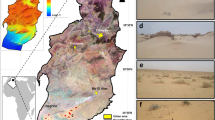This paper presents a classified desertification hazard map of Zayandeh Rood Basin (Z.R.B) in Iran. There are potential climatic factors, the geographical location and human activities for developing desertification. The present study is based on the preview models and main factors of desertification in the study area. The classification method is based on such main parameters as the characteristic of soil, management and climate. Each parameter includes a sub-indicator with a weighing of between one and two based on the MEDALUS model. DEM, LANDSAT images (ETM+), statistical data and vector map are used as the dataset for classifying the desertification map. The sum of score parameters was estimated by using a weighted average. In this study, Arc GIS 9.3 was used to analyze the vector and raster layer maps as well as a recognition survey of the study area using satellite images. In Z.R.B, the most important factors of desertification hazard are the geographical location of the area, salinization area, elevation, slope, and human activities. Thanks to the classification hazard map, the highest class is located on salinization, low vegetation, high wind erosion, low slope and elevation. Low-class area of the hazard map belongs to the largest part of the basin. An important factor of desertification in the area can be the geographical location of the basin located near the desert area. Using the raster data and GIS software are beneficial for the classification hazard map, especially for large areas.









Similar content being viewed by others
References
Afif A G et al. 2010 Use of GIS and remote sensing for environmental sensitivity assessment of north coastal part, Egypt; J. Am. Sci. 6(11) 632–646.
Ahmadi H, Abrisham E, Ekhtesasi M R et al. 2006 Assessment and mapping of desertification using MICD and ICD model in FakhrAbad, Mehriz region; Desert J. 10(1) 165–187.
Alavipanah S K and Zehtabian G R 2001 Remote sensing and GIS tools for planning and management; Nat. Resour. J. Iran 60 1.
Aminmansour M 2006 Drought and desertification in Iran; http://www.parstimes.com/environment/desertification_iran.html.
Consultant Engineering 1997a Surface water resources reports in Govkhooni Marsh, Yazd and Ardestan area.
Consultant Engineering 1997b Zayandeh Rood Basin and Govkhooni Marsh reports; Natural Resources Organization of Isfahan.
Consultant Engineering 2007 The plan of executive critical center of wind erosion in Sejzy Desert in Isfahan; Natural Resources Organization of Isfahan.
Dwivedi R S and Sreenivas K 1998 Delineation of salt-affected soils and waterlogged areas in the Indo-Gangetic plains using IRS-1C LISS-III data; Int. J. Remote Sens. 19(14) 2739–2751.
Ekhtesasi M R and Mohajeri S 1995 Method of classification for type and intensity of desertification in Iran erosion sedimentation potential with use of IRIFR. E. A and MPSIAK Models in Semi-Arid; http://www.fig.net/pub/proceedings/korea/full-papers/session28/alavipanah-zehtabian.htm.
Gosh T K 1993 Environmental impact analysis of desertification through remote sensing and land based information system; J. Arid Environ. 25 141–150.
Graetz R D, Pech R P and Davis A W 1988 The assessment and monitoring of sparsely vegetated rangelands using calibrated LANDSAT data; Int. J. Remote Sens. 9 1201–1222.
Greek National Committee for Combating Desertification 2001 Greek national action plan for combating desertification; Athens.
Gurung J D 2010 Gender and desertification; International Fund for Agricultural Development; Via Paolo di Dono 44 00142, Rome, Italy.
Hansen D B 1985 An evaluation of FWS and BLM geographic data processing capabilities; Proceedings, Annual Meeting of the American Society of Photogrammetry, Falls Church, Virginia; The America Society of Photogrammetery, pp. 712–727.
Jafarian M A 1986 Study of paleogeopraphy and evolution stages in Zayandeh Rood Valley; Research Publication of Isfahan University, Spring, 15p (in Persian).
Jing-hu P A N and Tian-yu L I 2010 Extracting desertification from LANDSAT imagery based on spectral mixture analysis and Albedo-Vegetation feature space; J. Natural Resourc. 25(11) 1960–1969.
Khodagholi M 2006 A survey of phyto-climatology of Zayandehroud basin; Pajouhesh Sazandegi 70 41–53.
Ladisa G, Todorovic M and Trisorio Liuzzi G 2002 Environmental sensitive areas to desertification model: Supplementary indicators accounting for particular environmental conditions of southern Italy; Proceedings of International Conference on Environmental Problems of the Mediterranean Region, Near East University, Nicosia, North Cyprus.
Sepehr A 2007 Quantitative assessment of desertification in south of Iran using MEDALUS method; Environ. Monit. Assess. 134 243–254.
Toomanian N et al. 2006 Pedodiversity and pedogenesis in Zayandeh-rud Valley; Central Iran Geomorphology 81 376–393.
Acknowledgements
This work was supported by the University of Malaya and the data gathered was supported by the Natural Resources Organization of Isfahan, Iran and Sepahan Andish Consulting Engineering for the Hazard Information Data (2007).
Author information
Authors and Affiliations
Corresponding author
Rights and permissions
About this article
Cite this article
BARZANI, M.M., KHAIRULMAINI, O.S. Desertification risk mapping of the Zayandeh Rood Basin in Iran. J Earth Syst Sci 122, 1269–1282 (2013). https://doi.org/10.1007/s12040-013-0348-1
Received:
Revised:
Accepted:
Published:
Issue Date:
DOI: https://doi.org/10.1007/s12040-013-0348-1




